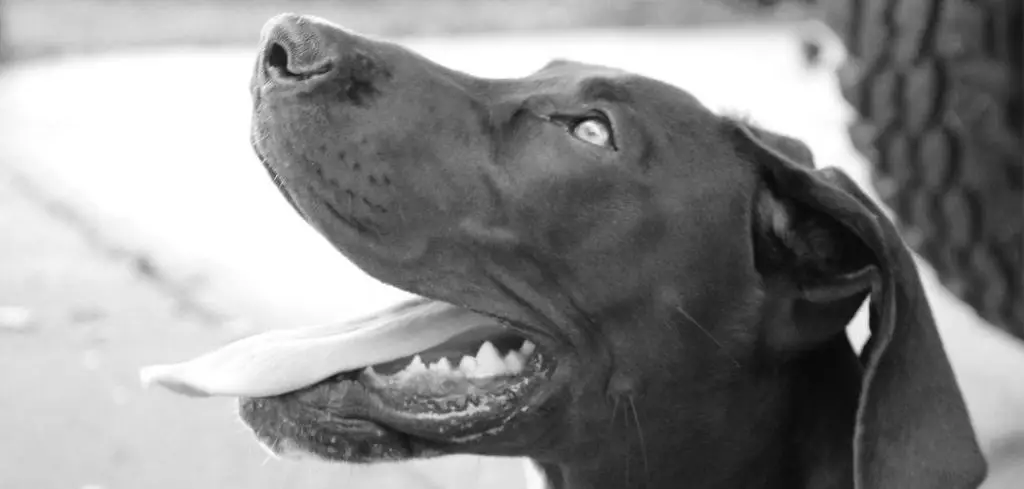It’s deeply alarming to see your dog panting heavily and gasping for air, especially when it happens suddenly or doesn’t stop.
These symptoms often signal that your dog is struggling to get enough oxygen — and that’s something no dog parent can ignore.
We outline what leads to a dog panting and gasping for air, what you can do at home, and when to seek veterinary help.
Table of Contents
Dog Panting and Gasping for Air — Why It Happens
When a dog is panting and gasping for air, it can point to serious issues involving the heart, lungs, airways, or overall body temperature.
Conditions like heart failure, tracheal collapse, laryngeal paralysis, or even heatstroke can lead to these distressing breathing patterns. Sometimes, pain, anxiety, or an allergic reaction might also contribute.
These symptoms should never be ignored, especially if your dog appears distressed or the behavior is unusual for them.

Dog Panting and Gasping for Air: Common Causes
Heart Disease
Heart conditions like congestive heart failure prevent proper circulation and oxygen delivery throughout the body.
When the heart can’t pump effectively, fluid may build up in the lungs, making it difficult for your dog to breathe.
You might notice coughing, panting even at rest, or gasping during minimal exertion.
Some dogs will also become lethargic or collapse. Heart disease is especially common in older dogs and certain breeds such as Cavalier King Charles Spaniels or Dobermans.
This condition is critical because it directly limits oxygen flow — which can make your dog gasp for air, particularly after light activity.
Related: Dog panting excessively (Causes and What To Do)
Tracheal Collapse
Small breed dogs like Chihuahuas, Pomeranians, and Yorkies are prone to tracheal collapse, where the cartilage rings in the windpipe weaken and collapse inward.
This makes it hard for air to pass through the windpipe, leading to labored breathing, a honking cough, and episodes of gasping.
It often worsens during excitement, heat, or exercise.
Because it obstructs the main airway, this can quickly escalate if not addressed — particularly during hot weather or stress.
Laryngeal Paralysis
In this condition, the muscles that open the larynx (voice box) become weak or paralyzed, restricting airflow during breathing.
It’s especially common in large, older dogs like Labradors.
Dogs may pant noisily, gasp, or have a raspy breathing sound, especially during activity.
They may avoid exercise or collapse after minimal exertion.
It’s dangerous because it interferes with air intake when your dog needs it most — during heat, stress, or movement.
Heatstroke
If your dog is panting and gasping for air on a hot day, heatstroke is a top concern.
Dogs don’t sweat like humans do — they rely on panting to cool down.
When their internal temperature rises too quickly, they may overheat, pant excessively, and begin gasping as oxygen demand skyrockets.
Signs include drooling, red gums, weakness, vomiting, and collapse. Flat-faced breeds like Bulldogs and Pugs are especially vulnerable.
Without rapid cooling and vet care, heatstroke can be fatal within minutes.
Allergic Reactions or Anaphylaxis
Severe allergic reactions to insect bites, food, or medications can trigger anaphylaxis — a rapid, life-threatening condition.
Airways may swell, making it hard for your dog to breathe. They might gasp, wheeze, or collapse suddenly.
Other signs can include swelling around the face, hives, or vomiting. Immediate veterinary attention is essential.
Even a few minutes of oxygen deprivation can have serious consequences.
Anxiety or Panic Attacks
In some cases, emotional distress can trigger intense panting and what appears to be gasping.
Dogs with separation anxiety, fear of thunderstorms, or trauma may hyperventilate.
They may appear wide-eyed, pace, tremble, or drool alongside rapid breathing.
While not always life-threatening, panic-induced gasping can become dangerous if it triggers other health issues — or mimics more serious conditions.
What to Do If Your Dog Is Panting and Gasping for Air
If your dog is gasping for air, start by staying calm. Panicking can stress your dog more.
Move them to a cool, quiet space away from heat or triggers. Limit activity and try to keep them relaxed while observing their symptoms closely.
If they are overheated, use cool — not ice-cold — water on their paws, ears, and underbelly, and offer small sips of water.
Avoid putting anything in your dog’s mouth or forcing movement.
Check their gum color: pale or blue gums signal oxygen deprivation and require immediate attention.
Even if they seem to recover, it’s wise to contact your vet — as some underlying issues may worsen without warning.
When to Call or Visit Your Vet
Call your vet or visit the emergency clinic if your dog:
Struggles to breathe or breathes with effort
Is gasping, wheezing, or has noisy breathing
Collapses or is too weak to stand
Has pale, gray, or blue gums
Shows signs of heatstroke
Has a history of heart or airway disease
Don’t wait to “see if it passes.” Gasping often means your dog is not getting enough oxygen, and delay can be fatal.
If symptoms come and go, record a video to show your vet — this can help diagnose intermittent breathing issues.
Read more: Dog Breathing Heavily and Not Eating (Here’s why)
Key Takeaway
Seeing your dog panting and gasping for air is scary — and rightly so. These symptoms usually indicate that something serious is affecting your dog’s ability to breathe.
From heart disease to heatstroke or airway collapse, quick action and veterinary input are key to protecting your dog’s health.
If you’re ever in doubt, trust your instincts and get help right away. Your prompt response can make all the difference.
